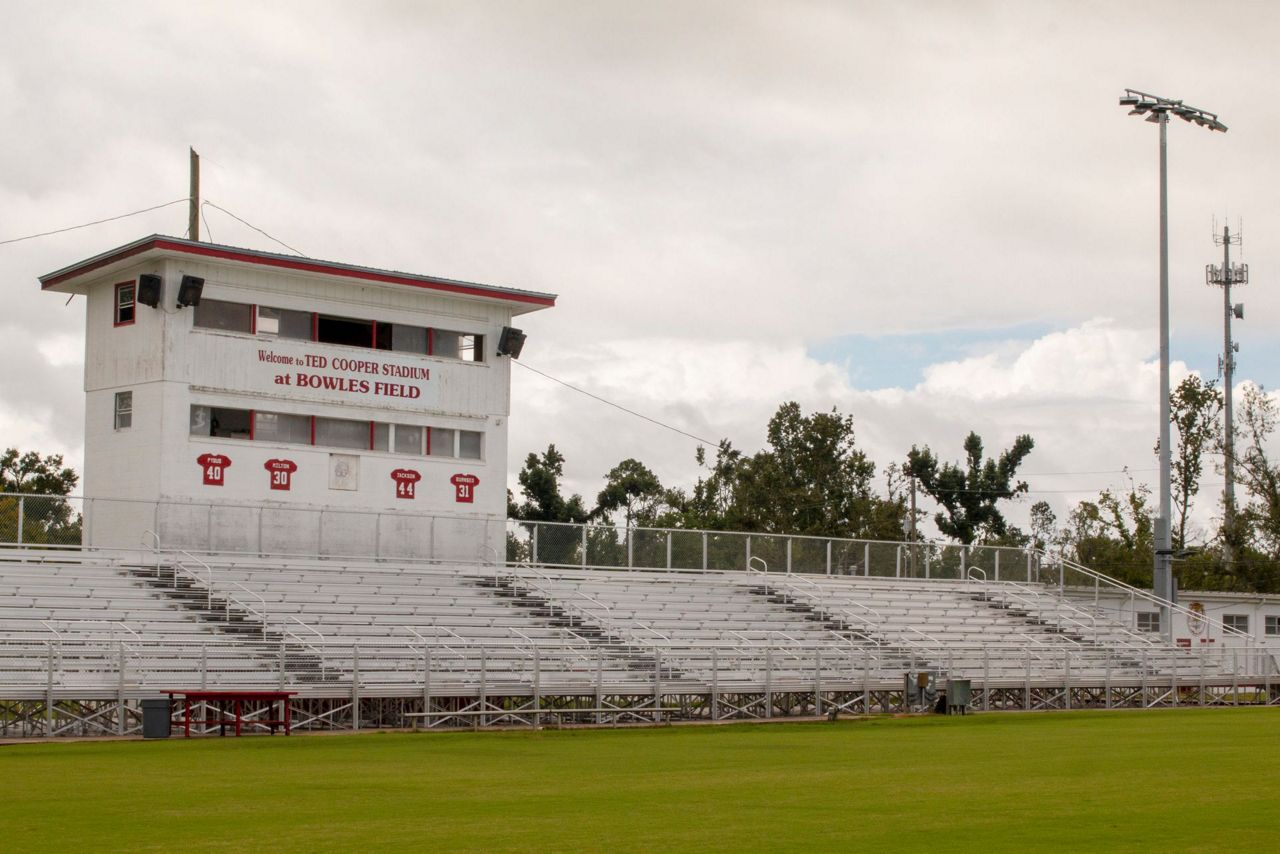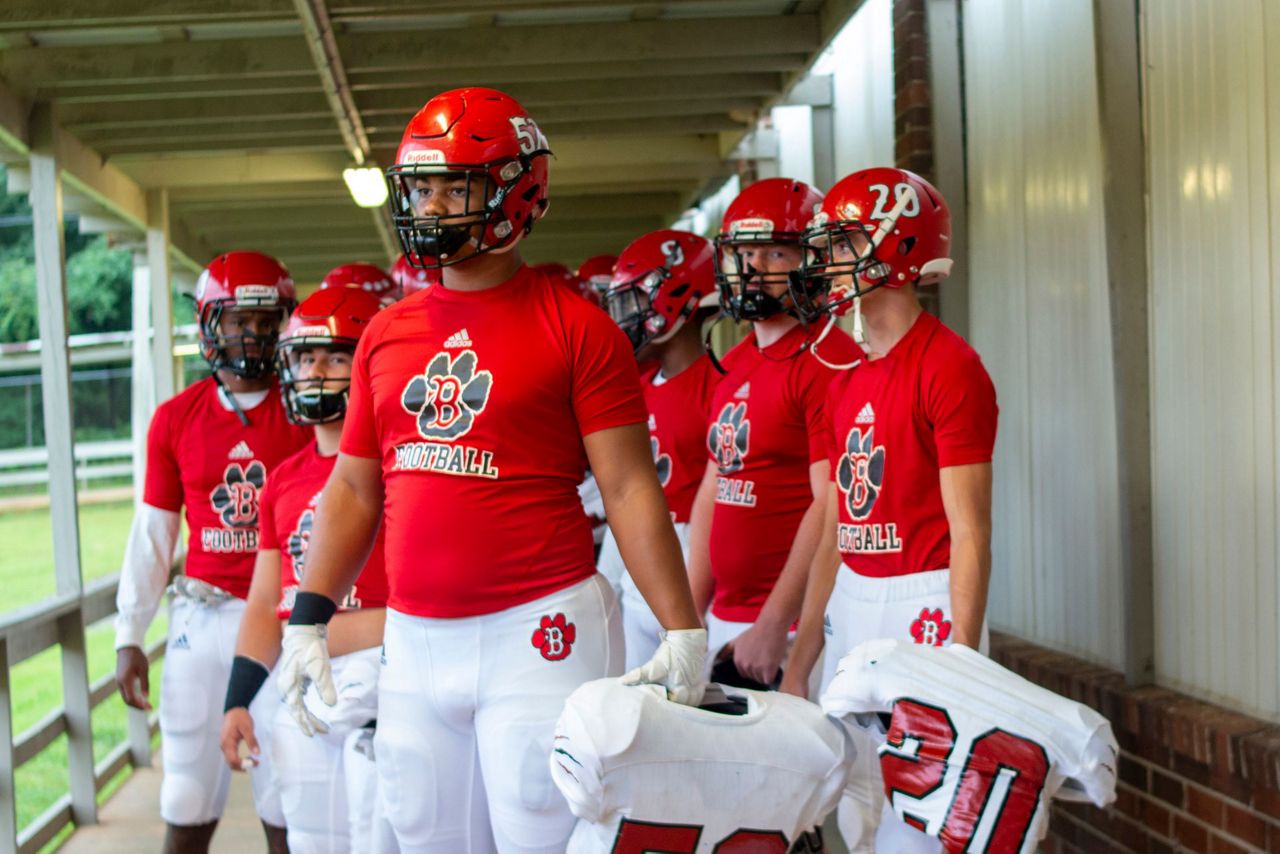BLOUNTSTOWN, Fla. (AP) — When the boys clad in red and white charged onto Bowles Field on Friday nights, the townsfolk packing the bleachers at Blountstown High could set aside the week's travails and cheer on the home team Tigers.
But last October, as the team racked up six wins against a single loss, Hurricane Michael hurtled across the Florida Panhandle, the region's most ferocious storm in recorded history. Nearly all of the 6,000 homes scattered across the woods of Calhoun County were damaged, and some were destroyed. At Bowles Field, 150 mph (241 kph) winds uprooted bleachers and tossed them across the soggy turf. The storm twisted goal posts and snapped the light poles that had brightened the field on Friday nights.
So when the Tigers opted to play out the rest of the season in the midst of the destruction, it once again gave the beleaguered community something to cheer about.
Now, the town's refurbished football field, a key center of public life, provides a tangible symbol of recovery. New bleachers flank the sidelines, and new lights atop sturdier metal poles will shine this Friday for the team's first home game, as Blountstown rallies for its team and for itself.
"To some this is just pic of a stadium and field. To us it's a sight that brings tears," Tigers football coach Beau Johnson tweeted about a photo in early August. "Beautiful sight to these TIGERS!"
Defensive end Carson Hatchett had lamented over rumors that there would be no home games in his senior year. "That was heartbreaking," he said.
His aunt, Samantha Taylor, said the community would not have let that happen.
"We are the Fighting Tigers. That is the spirit of our community," she said. "Getting knocked down is not the bad thing. Staying down is the bad thing."
For a while last week, Hurricane Dorian's uncertain path threatened to delay the first home game of the season. Folks feel fortunate to have been spared another round of chaos.
On the first day of school last month, hundreds showed up at an evening pep rally. Later that week, at the team's season-opening scrimmage an hour's drive away in Tallahassee, fans for the visiting Tigers outnumbered those of the home team.
And two weeks ago, in the first game of the season against the Arnold High Marlins 60 miles (97 kilometers) away in Panama City Beach, the Tigers delivered a 43-10 win.
For Ladona Kelley, whose son Zeb is a Tigers linebacker, it was a boost for town morale. But as the family liaison for Calhoun County Schools, she knows of the struggles that still linger.
"Even though it's been many months since Hurricane Michael hit our area, every day it's still impacting us," Kelley said.
Across town, blue tarps cover rooftops that have yet to be repaired. It could take years to restore the power lines and other infrastructure — not to mention damaged lives and livelihoods.
Fallen longleaf pines, snapped like twigs by the Hurricane's fierce winds, remain untouched across huge swaths of Calhoun County's 574 square miles. The pine forests, which sustained the community with logging jobs, could take decades, if not generations, to recover.
The Florida Department of Agriculture called the damage to Calhoun County's timber industry "catastrophic."
In all, Hurricane Michael caused more than $25 billion in damage as it swirled across the northern Florida coast, into Georgia and the Carolinas. Florida officials blamed the storm for at least 43 deaths. A Calhoun County teacher, the mother of a Blountstown High football player, was among those who perished.
As Hurricane Michael approached Florida's Gulf Coast last October, forecasts focused on picturesque beaches, tourist attractions and the pricey real estate — not on places like Calhoun County, an inland expanse of rural enclaves, the biggest of them 2,500-population Blountstown.
"People have forgotten about us because we're in a rural area and the hurricane didn't hit a big city," said Johnson, the football coach. "Maybe the outside world just didn't really know how bad it got."
Chris Cutchins, an offensive tackle for the Tigers, knows how bad it got — and how bad it still is.
He was in his family's single-wide trailer when the rumbling began. The family bolted for safety to a relative's sturdier brick house. Even then, the storm shook fear into him.
"You could hear the wind. It was shaking the door. Bricks were moving in a concrete house," Cutchins recalled.
When he and his family returned to their own home, they found a mangled mess. Their trailer's roof tore open, and the walls had caved in. Their camper toppled to its side.
He and his family righted the camper and spent the next 10 months in it, with no air conditioning or relief from the area's sweltering humidity.
Football should be the last thing on anyone's mind, especially when there's still so much work to do — but it can be a rallying force. For instance, in Paradise, California, where a November fire destroyed nearly 19,000 structures and killed 86 people, a football game last month brought out thousands of people .
"It helps provide some normalcy. It gives people something to focus on instead of their problems," said Blountsville city manager Traci Smith Hall, who was born and raised in the community.
That might explain why her son Brody, a center for the Tigers, knew how to respond when coach Johnson called the team together soon after last year's storm. Johnson offered a choice: Play out the rest of the season or regroup when their hearts and minds weren't so distracted.
The boys insisted they could play on — not for themselves, they said, but for their community.
"That was something good that could bring some hope to the community and a little bit of positivity," Brody said.
Linebacker Zeb Kelley echoed the sentiment: "We just knew we needed to play for the community."
___
Follow Bobby Caina Calvan at http://twitter.com/bobbycalvan
Copyright 2019 The Associated Press. All rights reserved. This material may not be published, broadcast, rewritten or redistributed.




